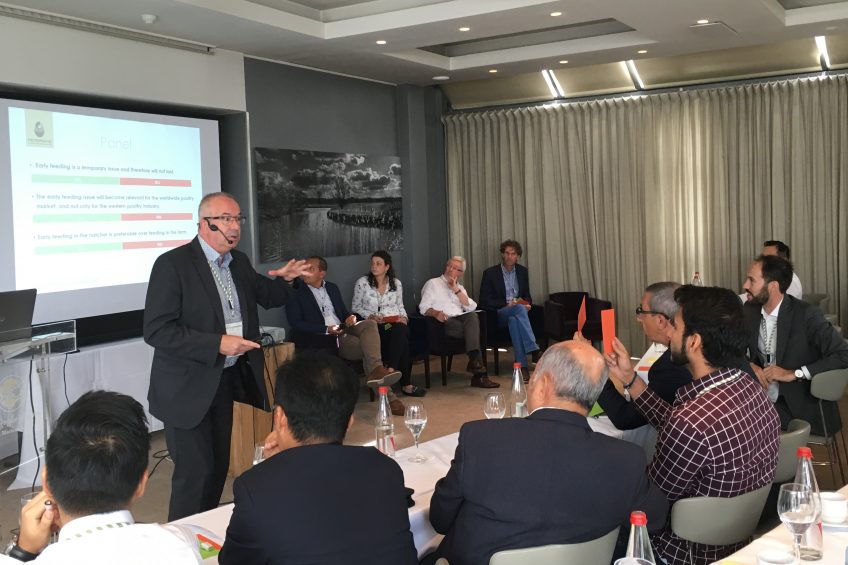Shake up of global trade is the main future challenge

The main challenges the poultry industry faces in the short and long term future are becoming more and more stable factors. Feed quality and price, disease, antibiotic reduction, animal welfare and environmental issues are there to stay. The real challenge now comes from the volatility of markets due to global trade constraints. Poultry World reports from the Petersime international congress in Belgium.
If there was one thing that shook up the poultry industry in recent years then it was the Avian Influenza outbreaks. Professor Arjan Stegeman from the University of Utrecht witnessed a change in virus presence from 2003 onwards. “Until then, Avian Influenza outbreaks were incidents where low pathogenic strains mutated into highly pathogenic ones. However, a high pathogenic strain of H5N1, that was discovered first in 1997 in Hong Kong, started a series of events from 2003 onwards.” According to Professor Stegeman the virus wasn’t controlled properly and eventually spilled over into the wild bird population. With that, bird migration poses a risk for commercial poultry in the northern hemisphere every fall. “Early signs we see now is that the virus is not limited to migration, but is becoming endemic in Europe as is the case in Indonesia, China, Vietnam and Egypt. The conclusion of this is that we have to learn to live with a constant Avian Influenza threat and do the utmost to keep our birds safe.”
This trend is also seen by Rabobank expert Nan-Dirk Mulder: “Avian Influenza has become an ongoing risk, a reality we have to live with. And as long as the industry is able to keep the virus out of commercial poultry or is able to eradicate the virus quickly, this will not have a large impact on the markets, at least not as large as in the past. Volatility will now come from global trade however. Recently we had the weak flesh scandal in Brazil, extra demands for halal production from the Middle East and Chinese taxes on Brazilian meat. Global trade streams are under heavy pressure and that shakes up everything.“When it comes to poultry meat production we see exports from Brazil to Europe being cut in half. According to Mr Mulder, Ukraine is filling some of the gap and Poland is expanding production fast, but breast meat prices must go up because these countries cannot put out enough. ‘’What we see in Poland is that 10 new processing facilities will come online soon and the country has a growth in production of 8% per year. That said, the new processors are desperately looking for birds to fill the lines.”
Disrupting tariffs
‘’And that is not all”, Mr Mulder warns. The China-US tariffs on soy will further shake up trade. “Because of the self-inflicted tariffs on US soy the feed prices in China will go up and soy prices in the US will come under pressure. China is now buying soy in Brazil pushing prices up and disrupting the already struggling poultry market there.” On a positive note he added: “Long term you are in the right market, but be aware that the growth potential is moving away from traditional markets. Both volume and value growth will happen for instance in Asia, where there still is a large upside for consumption/demand. Also Russia and Ukraine will focus more on exports, if not hindered by restrictions. That said, the road for the near future will be a bumpy one, with high volatility.”
Even with the known and unknown challenges, including trade uncertainty and volatility, the main goal will be feeding the world. Now and in the future. “And we have to do so, without eating our planet”, said emeritus professor Eddy DeCuypere. The challenge is to feed 9 billion people by 2050, who will eat more per capita than today. Knowing that today there are 800 million people undernourished, that seems like a daunting task. “I am sure that production is not the problem.
Even when resources are scarce and hardly any new land will be taken in production. The opposite is more realistic with growing cities, climate change and so on.” But Mr DeCuypere stays optimistic. “Of our earth only one third is land, of this land one third is used for agriculture. Of this agricultural land two thirds are pastures, one third used for crops. Last but not least one third of the arable land is used to produce animal feed. The meaning behind this thought is to prove there is a lot to win. When we focus on ‘useless’ land and useless proteins and shift to efficient animal production, we will have plenty to eat, without eating our planet. With that, we just have the challenge to get it to the right place via trade.”













